Gupta art
Gupta art is the art of the Gupta Empire, which ruled most of northern India, with its peak between about 300 and 480 CE, surviving in much reduced form until c. 550. The Gupta period is generally regarded as a classic peak and golden age of North Indian art for all the major religious groups.[2] Although painting was evidently widespread, the surviving works are almost all religious sculpture. The period saw the emergence of the iconic carved stone deity in Hindu art, while the production of the Buddha-figure and Jain tirthankara figures continued to expand, the latter often on a very large scale. The traditional main centre of sculpture was Mathura, which continued to flourish, with the art of Gandhara, the centre of Greco-Buddhist art just beyond the northern border of Gupta territory, continuing to exert influence. Other centres emerged during the period, especially at Sarnath. Both Mathura and Sarnath exported sculpture to other parts of northern India.
It is customary to include under "Gupta art" works from areas in north and central India that were not actually under Gupta control, in particular art produced under the Vakataka dynasty who ruled the Deccan c. 250–500.[3] Their region contained very important sites such as the Ajanta Caves and Elephanta Caves, both mostly created in this period, and the Ellora Caves which were probably begun then. Also, although the empire lost its western territories by about 500, the artistic style continued to be used across most of northern India until about 550,[4] and arguably around 650.[5] It was then followed by the "Post-Gupta" period, with (to a reducing extent over time) many similar characteristics; Harle ends this around 950.[6]
In general the style was very consistent across the empire and the other kingdoms where it was used.[7] The vast majority of surviving works are religious sculpture, mostly in stone with some in metal or terracotta, and architecture, mostly in stone with some in brick. The Ajanta Caves are virtually the sole survival from what was evidently a large and sophisticated body of painting,[8] and the very fine coinage the main survivals in metalwork.
Gupta India produced both textiles and jewellery, which are only known from representations in sculpture and especially the paintings at Ajanta.[9]
Background
Gupta art was preceded by Kushan art, the art of the Kushan Empire in northern India, which flourished between the 1st and the 4th century CE and blended the tradition of the Greco-Buddhist art of Gandhara, influenced by Hellenistic artistic canons, and the more Indian art of Mathura.[10] In Western India, as visible in Devnimori, the Western Satraps (1st-4th century CE) developed a refined art, representing a Western Indian artistic tradition that was anterior to the rise of Gupta art, and which may have influenced not only the latter, but also the art of the Ajanta Caves, Sarnath and other places from the 5th century onward.[11][12][13] In central India, the art of the Satavahanas had already created a rich Indian artistic idiom, as visible in Sanchi, which also influenced Gupta art.[13]
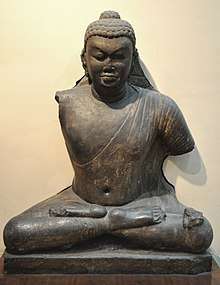
With the conquests of Samudragupta (r.c. 335/350-375 CE) and Chandragupta II (r.c. 380 – c. 415 CE), the Gupta Empire came to incorporate vast portions of central, northern and northwestern India, as far as the Punjab and the Arabian sea, continuing and expanding on these earlier artistic traditions and developing a unique Gupta style, rising "to heights of sophistication, elegance and glory".[15][16][17][18] Unlike some other Indian dynasties before and after them, and with the exception of the imagery on their coins, the Gupta imperial family did not advertise their relationship to the art produced under them by inscriptions, let alone portraits that have survived.[19]
Early chronology
There are a several pieces of statuary from the Gupta period which are inscribed with a date.[20] They work as a benchmark for the chronology and the evolution of style under the Guptas. These Gupta statues are dated from the Gupta era (which starts in 318–319 CE), and sometimes mention the reigning ruler of that time.[20] Besides statuary, coinage is also an important chronological indicator.[21]
Although the Gupta Empire is reckoned to start after King Gupta in the late 3rd century CE, the earliest known and dated sculptures of Gupta art come relatively late, about a century later, after the conquest of northwestern India under Samudragupta. Among the earliest is an inscribed pillar recording the installation of two Shiva Lingas in Mathura in 380 CE under Chandragupta II, Samudragupta's successor.[22] Another rare example is a statue of a seated Bodhisattva in the Mathura style with dhoti and shawl on the left shoulder, coming from Bodh Gaya and dated to "year 64", presumably of the Gupta era, thought to be 384 CE.[14] This type remained a rare occurrence, as in most of the later Gupta statues the Buddha would be shown with the samghati monastic robe covering both shoulders.[14]
Coinage too was a relatively late development, also consecutive to Samugragupta's conquest of the northwest.[23][24][25] The Gupta coinage was initially in imitation of the Kushan types.[26][27][28]
Sculpture
Three main schools of Gupta sculpture are often recognised, based in Mathura, Varanasi/Sarnath and to a lesser extent Nalanda.[29] The distinctively different stones used for sculptures exported from the main centres described below aids identification greatly.[30]
Both Buddhist and Hindu sculpture concentrate on large, often near life-size, figures of the major deities, respectively Buddha, Vishnu and Shiva. The dynasty had a partiality to Vishnu, who now features more prominently, where the Kushan imperial family generally had preferred Shiva. Minor figures such as yakshi, which had been very prominent in preceding periods, are now smaller and less frequently represented, and the crowded scenes illustrating Jataka tales of the Buddha's previous lives are rare.[31] When scenes include one of the major figures and other less important ones, there is a great difference in scale, with the major figures many times larger. This is also the case in representations of incidents from the Buddha's life, which earlier had showed all the figures on the same scale.[32]
The lingam was the central murti in most temples. Some new figures appear, including personifications of the Ganges and Yamuna rivers, not yet worshipped, but placed on either side of entrances; these were "the two great rivers encompassing the Gupta heartland".[33] The main bodhisattva appear prominently in sculpture for the first time,[34] as in the paintings at Ajanta. Buddhist, Hindu and Jain sculpture all show the same style,[35] and there is a "growing likeness of form" between figures from the different religions, which continued after the Gupta period.[4]
The Indian stylistic tradition of representing the body as a series of "smooth, very simplified planes" is continued, though poses, especially in the many standing figures, are subtly tilted and varied, in contrast to the "columnar rigidity" of earlier figures.[36] The detail of facial parts, hair, headgear, jewellery and the haloes behind figures are carved very precisely, giving a pleasing contrast with the emphasis on broad swelling masses in the body.[37] Deities of all the religions are shown in a calm and majestic meditative style; "perhaps it is this all-pervading inwardness that accounts for the unequalled Gupta and post-Gupta ability to communicate higher spiritual states".[4]
Mathura school
The long-established Mathura school continued as one of the main two schools of Gupta Empire art, joined by the school of Varanasi and nearby Sarnath.[1] Mathura sculpture is characterized by its usage of mottled red stone from Karri in the district, and its foreign influences, continuing the traditions of the art of Gandhara and the art of the Kushans.[38]
The art of Mathura continued to become more sophisticated during the Gupta Empire. The pink sandstone sculptures of Mathura evolved during the Gupta period to reach a very high fineness of execution and delicacy in the modeling, displaying calm and serenity. The style become elegant and refined, with a very delicate rendering of the draping and a sort of radiance reinforced by the usage of pink sandstone.[1] Artistic details tend to be less realistic, as seen in the symbolic shell-like curls used to render the hairstyle of the Buddha, and the orante halos around the head of the Buddhas. The art of the Gupta is often considered as the pinnacle of Indian Buddhist art, achieving a beautiful rendering of the Buddhist ideal.[1]
Gupta art is also characterized by an expansion of the Buddhist pantheon, with a high importance given to the Buddha himself and to new deities, including Bodhisattvas such as Avalokitesvara or divinities of Bramanical inspiration, and less focus on the events of the life of the Buddha which were abundantly illustrated through Jataka stories in the art of Bharhut and Sanchi (2nd–1st centuries BCE), or in the Greco-Buddhist art of Gandhara (1st–4th centuries CE).[39]
The Gupta art of Mathura was very influential throughout northern India, accompanied by a reducing of foreign influences; its style can be seen in Gupta statues to the east in areas as far as Allahabad, with the Mankuwar Buddha, dated to the reign of Kumaragupta I in 448.[40]
There are a number of "problematical" Buddhist and Jain images from Mathura whose dating is uncertain; many are dated with a low year number, but which era is being used is unclear. These may well come from the early Gupta period.[4]
- Standing Buddha, Mathura
.jpg) Standing Buddha, inscribed Gupta Era year 115 (434 CE), Mathura.[42]
Standing Buddha, inscribed Gupta Era year 115 (434 CE), Mathura.[42]- Head of a Buddha, 6th century.
- A relief of the Trivikrama , "three strides of Vishnu", in the art of Mathura during the Gupta period.
%2C_Gupta_period%2C_mid-5th_century_AD._Boston_Museum.jpg) Vishnu in three incarnations (Chaturvyuha): Vishnu himself or Vasudeva-Krishna in human form, Varaha as a boar, Narasimha as a lion. Mathura, mid-5th century CE. Boston Museum.[43]
Vishnu in three incarnations (Chaturvyuha): Vishnu himself or Vasudeva-Krishna in human form, Varaha as a boar, Narasimha as a lion. Mathura, mid-5th century CE. Boston Museum.[43] Vishnu statue, 5th century, Mathura.
Vishnu statue, 5th century, Mathura.- Seated Jain Tirthankara, circa 5th Century CE, Mathura.
Sarnath school
.jpg)
The Varanasi/ Sarnath style produced mainly Buddhist art, and "Sarnath Buddhas are probably the greatest single achievement of the Indian sculptor", largely setting the representation of the Buddha that was followed in eastern India and South-East Asia for many centuries, and the general representation of the human body in India.[45] A number of dated examples show that the mature style did not develop until 450–475.[46] It is characterized by its yellowish sandstone from the quarries of Chunar, and lacks the foreign influences seen in Mathura.[39] Folds on clothing have disappeared, and the clothing itself is extremely thin, to the point of being transparent. The halo has become large and is often elaborately decorated.[47] The top edge of the eye-socket is very marked, forming a sharply carved edge.[48]
The Sarnath style was the origin of Buddha images in Siam, Cambodia and Java.[49]
 The Mankuwar Buddha, with inscribed date "year 129 in the reign of Maharaja Kumaragupta", hence 448 CE.[50] Mankuwar, District of Allahabad. Lucknow Museum.[39][51]
The Mankuwar Buddha, with inscribed date "year 129 in the reign of Maharaja Kumaragupta", hence 448 CE.[50] Mankuwar, District of Allahabad. Lucknow Museum.[39][51] Buddha, standing, inscribed: "Gift of Abhayamira in 154 GE" (474 CE) in the reign of Kumaragupta II. Sarnath Museum.[52]
Buddha, standing, inscribed: "Gift of Abhayamira in 154 GE" (474 CE) in the reign of Kumaragupta II. Sarnath Museum.[52].jpg) 5th century Sarnath statue, Indian Museum.
5th century Sarnath statue, Indian Museum.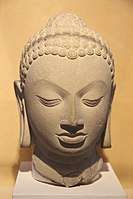 Buddha head, Sarnath, 5th century
Buddha head, Sarnath, 5th century- Buddha, 450-500
Other centres
- Nalanda
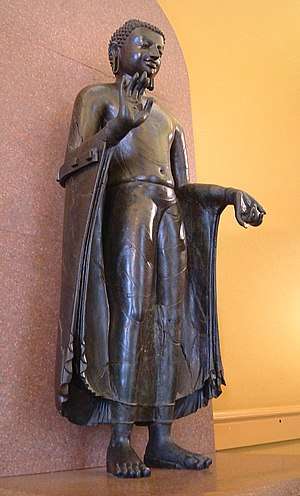
Gupta sculptural qualities tend to deteriorate with time, as in Nalanda in Bihar in the 6th century BCE, figures become heavier and tend to be made in metal. This evolution suggests a third school of Gupta art in the area Nalanda and Pataliputra, besides the two main centres of Mathura and Vanarasi. The colossal Sultanganj Buddha in bronze from the area of Pataliputra is a uniquely large survival from this school, but typical in style.[39] In the same monastery two similar but much smaller (and slightly later) figures in stone were found, one now on display in the British Museum.[53]
- Udayagiri Caves/Vidisha
The "first dated sculptures in a fully-fledged early Gupta style" come from the rock-cut Udayagiri Caves and the surrounding area near Vidisha in Madhya Pradesh.[54] Though the caves, all but one Hindu, are "of negligible importance architecturally", around the cave entrances are a number of rock relief panels, some with large deities. They are in a relatively crude and heavy style, but often with a powerful impact; Harle describes the mukhalinga in Cave 4 as "pulsating with psychic power". The most famous is the 7 x 4 metre relief of Vishnu in the form of the giant boar Varaha, raising the earth from the primordial waters, watched by rows of much smaller gods, sages and celestial beings. One cave also has an extremely rare inscription relating a site to the Gupta court, recording the donation of a minister of Candragupta II.[55] The famous Iron pillar of Delhi is thought likely to have been originally set up outside the caves.
.jpg)
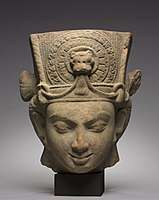 Head of Vishnu from Vidisha near Udayagiri, Central India, 4th century
Head of Vishnu from Vidisha near Udayagiri, Central India, 4th century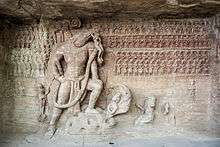 Vishnu in the form of Varaha, Udayagiri caves, 5th century
Vishnu in the form of Varaha, Udayagiri caves, 5th century
- Eran
Eran in Madhya Pradesh has a "pillar" or large single column dated 484/5 by an inscription of Buddhagupta, the only standing Gupta example, with two Garuda figures at the top (illustrated below). It had two large Varaha figures outside the ruined Gupta temple. The style of the sculpture is somewhat provincial. Still at the site is a huge and impressive boar on four legs, with no human characteristics, its body covered with rows of small figures representing the sages who clung to the hairs of Varaha to save themselves from the waters. Now moved to the university museum at Sagar is a figure with the same body and pose as that at Udayagiri, "one of the greatest of all Indian sculptures ... nothing can match the figure's air of insolent triumph". Both are dated to the late fifth century.[57]
- Others
The surviving sanctuary of the early 6th-century Dashavatara Temple, Deogarh has a typically fine doorway, and large relief panels on the other three walls. These are now external, but would originally gave given on to the covered ambulatory. Though "majestic", these show "the sturdiness of early Gupta sculpture is yielding to a softer, more delicate and ultimately weaker style".[58] The row of men beneath the sleeping Vishnu have "stylized poses, probably imitated from the theatre".[59]
There are also other minor centres of Gupta sculpture, particularly in the areas of Dasapura and Mandasor, where a huge eight-faced mukhalinga (probably early 6th-century) found in the river has been reinstalled in the Pashupatinath Temple, Mandsaur.[60]
The Greco-Buddhist art of Gandhara continued a late phase through at least most of the Gupta period, having also been a formative influence.[54]
_(cropped).jpg)
Very important rock-cut sites outside the Gupta Empire proper, to the south, are the Ajanta Caves and Elephanta Caves, both mostly created in the Gupta period, and the Ellora Caves which were probably begun around the end of it. As it was mainly restricted to the Gangetic plain, the vast Gupta territories included relatively few rock-cut sites with much sculpture. The later Ajanta style of sculpture is somewhat heavy, but sometimes "awe-inspiring" in the large seated shrine Buddhas, but other smaller figures are often very fine, as is the ornamental carving on columns and door-frames.[61] When combined with the painted walls, the effect can be considered over-decorated, and lacking "motifs on a larger scale to serve as focal points". The main internal carving was probably completed by 478, though votive figures to the sides of many cave entrances may be later. The Ajanta style is only seen at a few other sites nearby. After work ended there much of the skilled workforce, or their descendants, probably ended up working at Elephanta and then Ellora.[62]
Unlike the series of caves side by side at Ajanta, the main interest at Elephanta is the largest cave, a huge Shiva temple, and above all the colossal triple-bust (trimurti) of Shiva, 18 feet (5.5 m) tall, which "because it is so amazingly skilfully placed in relation to the various external entrances ... receives exactly the amount of light necessary to make it look as if it is emerging from a black void, manifestation from the unmanifest".[63] Also from the Mumbai area, the Parel Relief or (Parel Shiva) is an important late Gupta monolithic relief of Shiva in seven forms.[63]
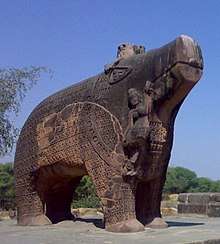
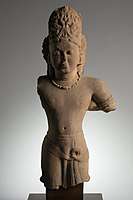 Vishnu, Central India, 5th century
Vishnu, Central India, 5th century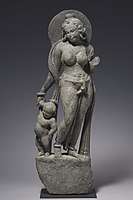 Mother Goddess from entrance of a Hindu Temple. Northwestern India, Rajasthan, 5th-6th century
Mother Goddess from entrance of a Hindu Temple. Northwestern India, Rajasthan, 5th-6th century
Terracotta sculpture
There are many sculptures in terracotta of very fine quality, and they are similar in style across the empire, to an even greater extent than the stone sculpture.[4] Some can still be seen in their original settings on the brick temple at Bhitargaon, where the large relief panels have almost worn away, but various heads and figures survive at higher levels.[64] The very elegant pair of river goddesses excavated from a temple at Ahichchhatra are 1.47 metres high. Buddhist sites such as Devnimori in Gujarat and Mirpur Khas in Sind have yielded numbers both of fine terracotta Buddhas and architectural ornament such as friezes.[65]
.jpg)
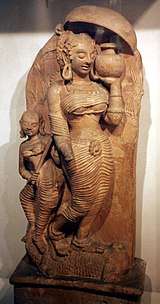
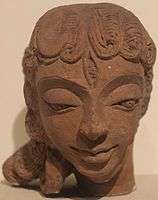 Terracotta head of Parvati, National Museum, New Delhi
Terracotta head of Parvati, National Museum, New Delhi
Sculpture in metal
The over life-size copper Sultanganj Buddha is "the only remaining metal statue of any size" from the Gupta period, out of what was at the time probably approximately as numerous a type as stone or stucco statues.[66] The metal Brahma from Mirpur-Khas is older, but about half the size. The Jain Akota bronzes and some other finds are much smaller still, probably figures for shrines in well-off homes.[67]
The style of the Sultanganj figure, made by lost-wax casting, is comparable to slightly earlier stone Buddha figures from Sarnath in "the smoothly rounded attenuation of body and limbs" and the very thin, clinging body garment, indicated in the lightest of ways. The figure has "a feeling of animation imparted by the unbalanced stance and the movement suggested by the sweeping silhouette of the enveloping robe".[66]
Coins and metalwork
.tif.jpg)
Survivals of decorated secular metalwork are very rare,[68] but a silver plate in the Cleveland Museum of Art shows a crowded festival scene in rather worn relief.[69] There is also a highly decorated object in bronzed iron that is thought to be a weight for an architect's "plummet" or measuring line, now in the British Museum.[70]
The gold coinage of the Guptas, with its many types and infinite varieties and its inscriptions in Sanskrit, are regarded as the finest coins in a purely Indian style.[71] The Gupta Empire produced large numbers of gold coins depicting the Gupta kings performing various rituals, as well as silver coins clearly influenced by those of the earlier Western Satraps by Chandragupta II.[72]
Coinage
Gupta coinage only started with the reign of Samudragupta (335/350-375 CE), or possibly at the end of the reign of his father Chandragupta I, for whom only one coin type in his name is known ("Chandragupta I and his queen"), probably a commemorative issue minted by his son.[23][24][25][73] The coinage of the Gupta Empire was initially derived from the coinage of the Kushan Empire, adopting its weight standard, techniques and designs, following the conquests of Samudragupta in the northwest.[24][25][74] The Guptas even adopted from the Kushans the name of Dinara for their coinage, which ultimately came from the Roman name Denarius aureus.[75][76][77] The imagery on Gupta coins was initially derived from Kushan types, but the features soon became more Indian in both style and subject matter compared to earlier dynasties, where Greco-Roman and Persian styles were mostly followed.[26][27][28]
The usual layout is an obverse with a portrait of the king that is normally full-length, whether standing, seated or riding a horse, and on the reverse a goddess, most often seated on a throne. Often the king is sacrificing. The choice of images can have political meaning, referring to conquests and local tastes; the types often vary between parts of the empire.[78]
Types showing the king hunting and killing various animals: lions (the "lion-slayer" type), tigers and rhinoceros very likely refer to new conquests in the areas where those animals were still found. They may also reflect influence from Sassanian silverware from Persia.[79] The king standing and holding a bow to one side (the "archer" type) was used by at least eight kings; it may have been intended to associate the king with Rama. Profile heads of the king are used on some silver coins for Western provinces added to the empire.[80]
Some gold coins commemorate the Vedic Ashvamedha horse sacrifice ritual, which the Gupta kings practiced; these have the sacrificial horse on the obverse and the queen on the reverse.[81] Samudragupta is shown playing a string instrument, wearing huge earrings, but only a simple dhoti. The only type produced under Chandragupta I shows him and his queen standing side by side. The bird Garuda, bearer of Vishnu, is used as a symbol of the dynasty on many silver coins.[82] Some of these were in the past misidentified as fire altars.[83]
The silver coinage of the Guptas was made in imitation of the coinage of the Western Satraps following their overthrow by Chandragupta II, inserting the Gupta peacock symbol on the reverse but retaining traces of the Greek legend and the ruler's portrait on the obverse.[84][85] Kumaragupta and Skandagupta continued with the old type of coins (the Garuda and the Peacock types) and also introduced some other new types.[71] The copper coinage was mostly confined to the era of Chandragupta II and was more original in design. Eight out of the nine types known to have been struck by him have a figure of Garuda and the name of the king on it. The gradual deterioration in design and execution of the gold coins and the disappearance of silver money, bear ample evidence to their curtailed territory.[71]
 Chandragupta I and his queen
Chandragupta I and his queen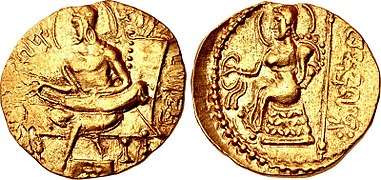 Samudragupta (left) playing a musical instrument; Goddess, right, c 335-380
Samudragupta (left) playing a musical instrument; Goddess, right, c 335-380.jpg) Samudragupta coin with Ashvamedha horse standing in front of a yūpa sacrificial post, with legend "The King of Kings, who had performed the Ashvamedha sacrifice, wins heaven after conquering the earth".[86][87]
Samudragupta coin with Ashvamedha horse standing in front of a yūpa sacrificial post, with legend "The King of Kings, who had performed the Ashvamedha sacrifice, wins heaven after conquering the earth".[86][87].jpg)
 Chandragupta II on horse
Chandragupta II on horse_(cropped).jpg) Archer type of Chandragupta II
Archer type of Chandragupta II_(cropped).jpg) Reverse of last; goddess seated on a lotus
Reverse of last; goddess seated on a lotus_(cropped).jpg) Kumaragupta I lion hunting on an elephant,
Kumaragupta I lion hunting on an elephant, Silver head of Skandagupta, peacock on reverse, 455-467
Silver head of Skandagupta, peacock on reverse, 455-467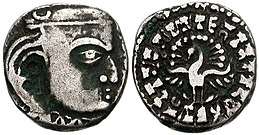 Silver head of Budhagupta, peacock on reverse, 476-495
Silver head of Budhagupta, peacock on reverse, 476-495
Architecture
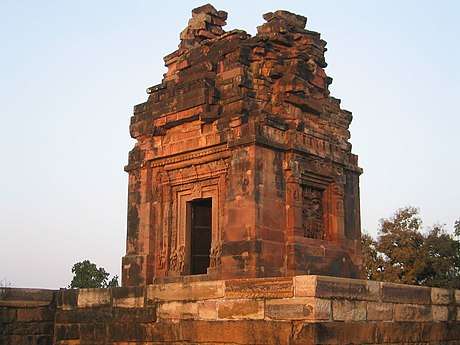
For reasons that are not entirely clear, for the most part the Gupta period represented a hiatus in Indian rock-cut architecture, with the first wave of construction finishing before the empire was assembled, and the second wave beginning in the late 5th century, just as it was ending. This is the case, for example, at the Ajanta Caves, with an early group made by 220 CE at the latest, and a later one probably all after about 460.[88] Instead, the period has left almost the first surviving free-standing structures in India, in particular the beginnings of Hindu temple architecture. As Milo Beach puts it: "Under the Guptas, India was quick to join the rest of the medieval world in a passion for housing precious objects in stylized architectural frameworks",[89] the "precious objects" being primarily the icons of gods.
The most famous remaining monuments in a broadly Gupta style, the caves at Ajanta, Elephanta, and Ellora (respectively Buddhist, Hindu, and mixed including Jain) were in fact produced under other dynasties in Central India, and in the case of Ellora after the Gupta period, but primarily reflect the monumentality and balance of Guptan style. Ajanta contains by far the most significant survivals of painting from this and the surrounding periods, showing a mature form which had probably had a long development, mainly in painting palaces.[90] The Hindu Udayagiri Caves actually record connections with the dynasty and its ministers,[91] and the Dashavatara Temple at Deogarh is a major temple, one of the earliest to survive, with important sculpture, although it has lost its mandapa and covered ambulatory for parikrama.[92]
Examples of early North Indian Hindu temples that have survived after the Udayagiri Caves in Madhya Pradesh include those at Tigawa (early 5th century),[93] Sanchi Temple 17 (similar, but respectively Hindu and Buddhist), Deogarh, Parvati Temple, Nachna (465),[94] Bhitargaon, the largest Gupta brick temple to survive,[95] and Lakshman Brick Temple, Sirpur (600–625 CE). Gop Temple in Gujarat (c. 550 or later) is an oddity, with no surviving close comparator.[96]
There are a number of different broad models, which would continue to be the case for more than a century after the Gupta period, but temples such as Tigawa and Sanchi Temple 17, which are small but massively built stone prostyle buildings with a sanctuary and a columned porch, show the most common basic plan that is elaborated in later temples to the present day. Both of these have flat roofs over the sanctuary, which would become uncommon by about the 8th century. The Mahabodhi Temple, Bhitargaon, Deogarh and Gop already all show high superstructures of different shapes.[97] The Chejarla Kapoteswara temple demonstrates that free-standing chaitya-hall temples with barrel roofs continued to be built, probably with many smaller examples in wood.[98]
 A tetrastyle prostyle Gupta period temple at Sanchi besides the Apsidal hall with Maurya foundation, an example of Buddhist architecture. 5th century
A tetrastyle prostyle Gupta period temple at Sanchi besides the Apsidal hall with Maurya foundation, an example of Buddhist architecture. 5th century The Hindu Tigawa Temple, early 5th century.
The Hindu Tigawa Temple, early 5th century.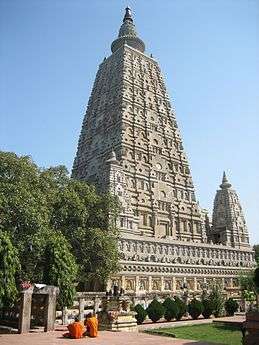 The current structure of the Mahabodhi Temple dates to the Gupta era, 5th century. Marking the location where the Buddha is said to have attained enlightenment.
The current structure of the Mahabodhi Temple dates to the Gupta era, 5th century. Marking the location where the Buddha is said to have attained enlightenment.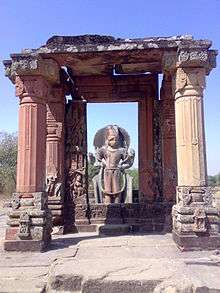 Vishnu temple in Eran, late 5th century.
Vishnu temple in Eran, late 5th century. The Buddhagupta pillar at Eran, 484/5
The Buddhagupta pillar at Eran, 484/5
Painting
Painting was evidently a major art in Gupta times, and the varied paintings of the Ajanta Caves, which are much the best survivals (almost the only ones), show a very mature style and technique, clearly the result of a well-developed tradition.[99] Indeed, it is recorded that skill in amateur painting, especially portraits, was considered a desirable accomplishment among Gupta elites, including royalty. The other survivals are from the Bagh Caves, now mostly removed to the Gujari Mahal Archaeological Museum in Gwalior Fort, Ellora, and Cave III of the Badami cave temples.[100]
At Ajanta, it is thought that established teams of painters, used to decorating palaces and temples elsewhere, were brought in when required to decorate a cave. Mural paintings survive from both the earlier and later groups of the caves. Several fragments of murals preserved from the earlier caves (Caves 10 and 11) are effectively unique survivals of ancient painting in India from this period, and "show that by Sātavāhana times, if not earlier, the Indian painters had mastered an easy and fluent naturalistic style, dealing with large groups of people in a manner comparable to the reliefs of the Sāñcī toraņa crossbars".[101]
Four of the later caves have large and relatively well-preserved mural paintings which "have come to represent Indian mural painting to the non-specialist",[101] and represent "the great glories not only of Gupta but of all Indian art".[102] They fall into two stylistic groups, with the most famous in Caves 16 and 17, and what used to thought of as later paintings in Caves 1 and 2. However, the widely accepted new chronology proposed by Spink places both groups in the 5th century, probably before 478.[103]
The paintings are in "dry fresco", painted on top of a dry plaster surface rather than into wet plaster.[104] All the paintings appear to be the work of painters supported by discriminating connoisseurship and sophisticated patrons from an urban atmosphere. Unlike much Indian mural painting, compositions are not laid out in horizontal bands like a frieze, but show large scenes spreading in all directions from a single figure or group at the centre.[105] The ceilings are also painted with sophisticated and elaborate decorative motifs, many derived from sculpture.[106] The paintings in cave 1, which according to Spink was commissioned by Harisena himself, concentrate on those Jataka tales which show previous lives of the Buddha as a king, rather than as a deer or elephant or other animal.[107] The Ajanta paintings have seriously deteriorated since they were rediscovered in 1819, and are now mostly hard to appreciate at the site. A number of early attempts to copy them met with misfortune.
Only mural paintings survive, but it is clear from literary sources that portable paintings, including portraits, were common, probably including illustrated manuscripts.[104]
- Cave 1 at Ajanta
Influences in Southeast Asia
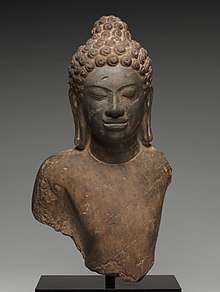
Indian art, particularly Gupta and Post-Gupta art from Eastern India, was influential in the development of Buddhist and Hindu art in Southeast Asia from the 6th century CE.[113] The Mon people of the kingdom of Dvaravati in modern Thailand were among the first to adopt Buddhism, and developed a particular style of Buddhist art. Mon-Davarati statues of the Buddha have facial features and hair styles reminiscent of the art of Mathura.[113] In pre-Angkorian Cambodia from the 7th century CE, Harihara statues fusing the characteristics of Shiva and Vishnu are known.[113]
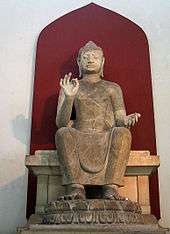 A seated Buddha in Dvaravati style, 6th century CE
A seated Buddha in Dvaravati style, 6th century CE_(6364064821).jpg) Harihara statue, Cambodia, 7th century CE
Harihara statue, Cambodia, 7th century CE
Notes
- Mookerji, 142
- Rowland's chapter 15 is called "The Golden Age: The Gupta Period; Harle, 88
- Harle, 118
- Harle, 89
- Rowland, 215
- Harle, 199
- Harle, 89; Rowland, 216
- Harle, 88, 355–361
- Rowland, 252–253
- Stokstad, Marilyn; Cothren, Michael W. (2013). Art History (5th Edition) Chapter 10: Art Of South And Southeast Asia Before 1200. Pearson. pp. 306–308. ISBN 978-0205873487.
- Schastok, Sara L. (1985). The Śāmalājī Sculptures and 6th Century Art in Western India. BRILL. pp. 23–31. ISBN 978-9004069411.
- The Journal of the International Association of Buddhist Studies, Volume 4 1981 Number I An Exceptional Group of Painted Buddha Figures at Ajanṭā, p.97 and Note 2
- "Gupta art in north India of the fifth century did receive the heritage of the Mathura as well as Ksatrapa-Satavahana arts." in Pal, Pratapaditya (1972). Aspects of Indian Art: Papers Presented in a Symposium at the Los Angeles County Museum of Art, October, 1970. Brill Archive. p. 47. ISBN 9789004036253.
- Rhi, Ju-Hyung (1994). "From Bodhisattva to Buddha: The Beginning of Iconic Representation in Buddhist Art". Artibus Asiae. 54 (3/4): 223. doi:10.2307/3250056. ISSN 0004-3648. JSTOR 3250056.
- Duiker, William J.; Spielvogel, Jackson J. (2015). World History. Cengage Learning. p. 279. ISBN 9781305537781.
- Mookerji, Radhakumud (1997). The Gupta Empire. Motilal Banarsidass Publ. p. 143. ISBN 9788120804401.
- Gokhale, Balkrishna Govind (1995). Ancient India: History and Culture. Popular Prakashan. pp. 171–173. ISBN 9788171546947.
- Lowenstein, Tom (2012). The Civilization of Ancient India and Southeast Asia. The Rosen Publishing Group, Inc. p. 53. ISBN 9781448885077.
- Harle, 88
- Agrawal, Ashvini (1989). Rise and Fall of the Imperial Guptas. Motilal Banarsidass Publ. pp. 98–100. ISBN 978-81-208-0592-7.
- Pal, 69
- "Collections-Virtual Museum of Images and Sounds". vmis.in. American Institute of Indian Studies.
- Altekar, A. s (1957). Coinage Of The Gupta Empire. p. 39.
- Mookerji, Radhakumud (1997). The Gupta Empire. Motilal Banarsidass Publ. p. 30. ISBN 9788120804401.
- Higham, Charles (2014). Encyclopedia of Ancient Asian Civilizations. Infobase Publishing. p. 82. ISBN 9781438109961.
- "It was his conquests which brought to him the gold utilized in his coinage and also the knowledge of its technique acquired from his acquaintance with Kushan (eastern Punjab) coins. His earliest coins began as imitations of these Kushan coins, and of their foreign features which were gradually replaced by Indian features in his later coins." in Mookerji, Radhakumud (1997). The Gupta Empire. Motilal Banarsidass Publ. p. 30. ISBN 9788120804401.
- Pal, 78
- Art, Los Angeles County Museum of; Pal, Pratapaditya (1986). Indian Sculpture: Circa 500 B.C.-A.D. 700. University of California Press. p. 73. ISBN 9780520059917.
- Mookerji, 1, 143
- Harle, 89; Rowland, 216; Mookerji, 143
- Harle, 87–88
- Rowland, 234
- Harle, 87–88, 88 quoted
- Rowland, 235
- Rowland, 232
- Rowland, 233
- Rowland, 230–233, 232 and 233 quoted
- Rowland, 229–232; Mookerji, 143
- Mookerji, 143
- Mookerji, 142–143
- "Kushana-Gupta transitional period" per Mathura Museum label, visible on the photograph.
- "Collections-Virtual Museum of Images and Sounds". vmis.in. American Institute of Indian Studies.
- For English summary, see page 80 Schmid, Charlotte (1997). Les Vaikuṇṭha gupta de Mathura : Viṣṇu ou Kṛṣṇa?. pp. 60–88.
- Rowland, 234–235; Harle, 109–110
- Harle, 107–110, 107 quoted
- Harle, 110
- Rowland, 232–237;
- Harle, 89–90
- Harle, 109–110; Rowland, 235
- Fleet, John Faithfull (1960). Inscriptions Of The Early Gupta Kings And Their Successors. p. 47.
- "Mankuwar Buddha Image Inscription of the Time of Kumaragupta I siddham". siddham.uk.
- "Collections-Virtual Museum of Images and Sounds". vmis.in. American Institute of Indian Studies.
- British Museum page
- Harle, 92
- Harle, 92–97, 93 quoted
- Harle, 93
- Harle, 97–100, 99–100 quoted
- Harle, 113
- Harle, 113–114
- Mookerji, 144; Harle, 114
- Harle, 118-120 (120 quoted), 122-124
- Harle, 122
- Harle, 124
- Harle, 115
- Harle, 117
- Rowland, 237
- Rowland, 237–239
- Rowland, 253
- "Plate with a Scene of Revelry", Cleveland Museum of Art
- Rowland, 253–254
- The Coins Of India, by Brown, C.J. p.13-20
- Allan, J. & Stern, S. M. (2008), coin, Encyclopædia Britannica.
- Brown, C. J. (1987). The Coins of India. Asian Educational Services. p. 41. ISBN 9788120603455.
- Sen, Sudipta (2019). Ganges: The Many Pasts of an Indian River. Yale University Press. p. 205. ISBN 9780300119169.
- "Known by the term Dinars in early Gupta inscriptions, their gold coinage was based on the weight standard of the Kushans i.e. 8 gms/120 grains. It was replaced in the time of Skandagupta by a standard of 80 ratis or 144 grains" Vanaja, R. (1983). Indian Coinage. National Museum.
- Mookerji, Radhakumud (1997). The Gupta Empire. Motilal Banarsidass Publ. p. 31. ISBN 9788120804401.
- Gupta inscriptions using the term "Dinara" for money: No 5-9, 62, 64 in Fleet, John Faithfull (1960). Inscriptions Of The Early Gupta Kings And Their Successors.
- Mookerji, 139–141; Bajpai, 121; Pal, 78–80
- Sircar, 215–217; Pal, 74–75. The alternative explanation is that these animals were still more widespread than is usually thought.
- Mookerji, 139–141; Pal, 73–74
- Glucklich, 111–113; Mookerji, 140; Pal, 79–80 suggests instead the female figure may represent Vijaya, the goddess of victory.
- Mookerji, 139–141; Pal, 73–75
- Bajpai, 121–124
- Prasanna Rao Bandela (2003). Coin splendour: a journey into the past. Abhinav Publications. pp. 112–. ISBN 978-81-7017-427-1. Retrieved 21 November 2011.
- "Evidence of the conquest of Saurastra during the reign of Chandragupta II is to be seen in his rare silver coins which are more directly imitated from those of the Western Satraps... they retain some traces of the old inscriptions in Greek characters, while on the reverse, they substitute the Gupta type (a peacock) for the chaitya with crescent and star." in Rapson "A catalogue of Indian coins in the British Museum. The Andhras etc...", p. cli
- Houben, Jan E. M.; Kooij, Karel Rijk van (1999). Violence Denied: Violence, Non-Violence and the Rationalization of Violence in South Asian Cultural History. BRILL. p. 128. ISBN 978-90-04-11344-2.
- Ganguly, Dilip Kumar (1984). History and Historians in Ancient India. Abhinav Publications. p. 152. ISBN 978-0-391-03250-7.
- Ajanta chronology is still under discussion, but this is the view of Spink, accepted by many.
- Beach, Milo, Steps to Water: The Ancient Stepwells of India, (Photographs by Morna Livingston), p. 25, 2002, Princeton Architectural Press, ISBN 1568983247, 9781568983240, google books
- J.C. Harle 1994, pp. 118–22, 123–26, 129–35.
- J.C. Harle 1994, pp. 92–97.
- Harle, 113–114; see also site entries in Michell (1990)
- Michell (1990), 192
- Michael Meister (1987), Hindu Temple, in The Encyclopedia of Religion, editor: Mircea Eliade, Volume 14, Macmillan, ISBN 0-02-909850-5, page 370
- Michell (1990), 157; Michell (1988), 96
- Harle, 111–113, 136–138; Michell (1988), 90, 96–98; see also site entries in Michell (1990)
- Harle, 111–113; Michell (1988), 94–98
- Harle, 175
- Honour, Hugh; Fleming, John (2005). A World History of Art. Laurence King Publishing. p. 244. ISBN 978-1-85669-451-3.
- Harle, 355, 361
- Harle, 355
- Harle, 356
- Harle, 355–361; Spink
- Harle, 361
- Harle, 359
- Harle, 355–361
- Spink 2008
- "Mahajanaka Jataka: Ajanta Cave 1". University of Minnesota.
- Benoy Behl (2004), Ajanta, the fountainhead, Frontline, Volume 21, Issue 20
- Gupte & Mahajan 1962, pp. 32–33, Plate XI.
- Gupte & Mahajan 1962, pp. 8–9, Plate IV.
- Spink 2009, pp. 138–140.
- Stokstad, Marilyn; Cothren, Michael W. (2013). Art History (5th Edition) Chapter 10: Art Of South And Southeast Asia Before 1200. Pearson. pp. 323–325. ISBN 978-0205873487.
References
| Wikimedia Commons has media related to Art of the Gupta period. |
- Bajpai, K. D., Indian Numismatic Studies, 2004, Abhinav Publications, ISBN 8170170354, 9788170170358, google books
- Glucklich, Ariel (2007). The Strides of Vishnu: Hindu Culture in Historical Perspective. Oxford University Press. ISBN 9780195314052.
- Gupte, Ramesh Shankar; Mahajan, B. D. (1962). Ajanta, Ellora and Aurangabad Caves. D. B. Taraporevala.CS1 maint: ref=harv (link)
- Harle, J.C., The Art and Architecture of the Indian Subcontinent, 2nd edn. 1994, Yale University Press Pelican History of Art, ISBN 0300062176
- Mookerji, Radhakumud (1997), The Gupta Empire, Motilal Banarsidass Publ., ISBN 9788120804401, google books
- Michell, George (1988), The Hindu Temple: An Introduction to its Meaning and Forms, 2nd edn., University of Chicago Press, ISBN 978-0-226-53230-1
- Michell, George (1990), The Penguin Guide to the Monuments of India, Volume 1: Buddhist, Jain, Hindu, 1990, Penguin Books, ISBN 0140081445
- Rowland, Benjamin, The Art and Architecture of India: Buddhist, Hindu, Jain, 1967 (3rd edn.), Pelican History of Art, Penguin, ISBN 0140561021
- Pal, Pratapaditya, Indian Sculpture: Circa 500 B.C.-A.D. 700, Volume 1 of Indian Sculpture: A Catalogue of the Los Angeles County Museum of Art Collection, 1986, Los Angeles County Museum of Art/University of California Press, ISBN 0520059913, 9780520059917, google books
- Sircar, D.C., Studies in Indian Coins, 2008, Motilal Banarsidass Publisher, 2008, ISBN 8120829735, 9788120829732, google books
- Spink, Walter M. (2008), Ajanta Lecture, Korea May 2008 (revised September 2008)
.jpg)
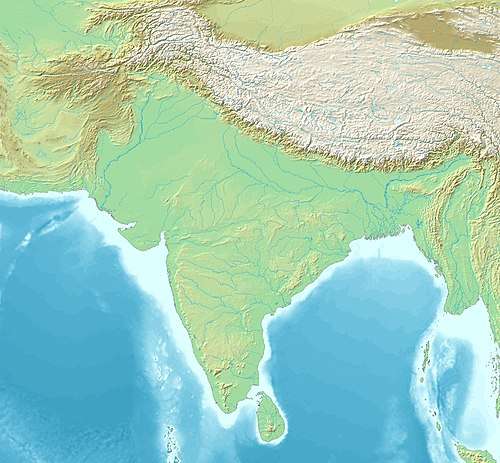

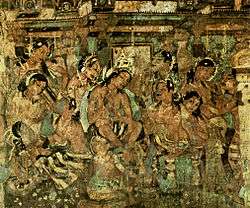
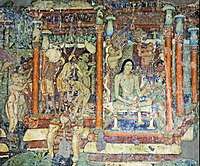
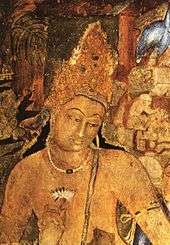
.jpg)